River Sand and Gravel Mining Monitoring Using Remote Sensing and UAVs
Abstract
1. Introduction
2. Materials and Methods
2.1. The Buzau River (Romania)
2.2. The Kallifitos Torrent (Greece)
2.3. The Collected Data
3. Results
3.1. The Buzau River (Romania)
3.2. The Kallifitos Torrent (Greece)
- <-1.51;
- -1.50 to -1.01;
- -1.00 to -0.51;
- -0.50 to -0.21;
- -0.20 to -0.11;
- -0.10 to 0.10;
- 0.11 to 0.20;
- 0.21 to 0.50;
- 0.51 to 1.00;
- 1.01 to 1.50;
- >1.51
4. Discussion
5. Conclusions
Author Contributions
Funding
Institutional Review Board Statement
Informed Consent Statement
Data Availability Statement
Acknowledgments
Conflicts of Interest
References
- Bendixen, M.; Iversen, L.L.; Best, J.; Franks, D.M.; Hackney, C.R.; Latrubesse, E.M.; Tusting, L.S. Sand, gravel, and UN Sustainable Development Goals: Conflicts, synergies, and pathways forward. One Earth 2021, 4, 1095–1111. [Google Scholar] [CrossRef]
- Fainisi, F.; Fainisi, V.A. Comparative analysis on the regulation of mineral resources in the member states of the European Union. Econ. Manag. Financ. Mark. 2017, 12, 248–269. [Google Scholar]
- Law of Water 107/1996, with subsequent amendments. Published in Monitorul Oficial no. 244/1996, Law of Environment 137/1995, with subsequent amendments. Published in Monitorul Oficial no. 304/30/1995.
- UNECE. Environmental Performance Review of Romania, 3rd ed.; United Nations: Geneva, Switzerland, November 2021. [Google Scholar]
- Podimata, M.V.; Yannopoulos, P.C. A conceptual approach to model sand–gravel extraction from rivers based on a game theory perspective. J. Environ. Plan. Manag. 2016, 59, 120–141. [Google Scholar] [CrossRef]
- Peduzzi, P. Sand, rarer than one thinks. Environ. Dev. 2014, 11, 208–218. [Google Scholar]
- Amiri-Tokaldany, E.; Darby, S.E.; Tosswell, P. Bank stability analysis for predicting reach scale land loss and sediment yield. J. Am. Water Resour. Assoc. 2003, 39, 897–909. [Google Scholar] [CrossRef]
- Dotterweich, M. The history of soil erosion and fluvial deposits in small catchments of central Europe: Deciphering the long-term interaction between humans and the environment—A review. Geomorphology 2008, 101, 192–208. [Google Scholar] [CrossRef]
- Koehnken, L.; Rintoul, M.S.; Goichot, M.; Tickner, D.; Loftus, A.C.; Acreman, M.C. Impacts of riverine sand mining on freshwater ecosystems: A review of the scientific evidence and guidance for future research. River Res. Appl. 2020, 36, 362–370. [Google Scholar] [CrossRef]
- Tiess, G. Minerals policy in Europe: Some recent developments. Resour. Policy 2010, 35, 190–198. [Google Scholar] [CrossRef]
- Kivinen, S.; Kotilainen, J.; Kumpula, T. Mining conflicts in the European Union: Environmental and political perspectives. Fennia 2020, 198, 163–179. [Google Scholar] [CrossRef]
- Bringezu, S. Towards sustainable resource management in the European Union. Wupp. Pap. 2002, 121, 50. [Google Scholar]
- UNEP. Sand and Sustainability: Finding New Solutions for Environmental Governance of Global Sand Resources; United Nations Environment Programme: Geneva, Switzerland, 2019. [Google Scholar]
- De Leeuw, N.H.; Catlow, C.R.A.; King, H.E.; Putnis, A.; Muralidharan, K.; Deymier, P.; Stimpfl, M.; Drake, M.J. Where on Earth has our water come from? ChemComm 2010, 46, 8923–8925. [Google Scholar] [CrossRef]
- Drozdz, M. Maps and protest. In International Encyclopedia of Human Geography; Kobayashi, A., Ed.; Elsevier: Amsterdam, The Netherlands, 2020; pp. 367–378. [Google Scholar] [CrossRef]
- Mayes, W.M.; Jarvis, A.P.; Burke, I.T.; Walton, M.; Feigl, V.; Klebercz, O.; Gruiz, K. Dispersal and attenuation of trace contaminants downstream of the Ajka bauxite residue (red mud) depository failure, Hungary. Environ. Sci. Technol. 2011, 45, 5147–5155. [Google Scholar] [CrossRef]
- Kosyan, R.D.; Velikova, V.N. Coastal zone–Terra (and aqua) incognita–Integrated coastal zone management in the Black Sea. Estuar. Coast. Shelf Sci. 2016, 169, A1–A16. [Google Scholar] [CrossRef]
- Żuk, L.; Królewicz, S. Uses of Sentinel-1 and -2 Images in Heritage Management: A Case Study from Lednica Landscape Park (Poland). Geosciences 2022, 12, 159. [Google Scholar] [CrossRef]
- Guneroglu, A.; Dihkan, M.; Karsli, F. Dynamic management of the coasts: Marine spatial planning. Proc. Inst. Civ. Eng. Marit. Eng. 2014, 167, 144–153. [Google Scholar] [CrossRef]
- Carpa, R.; Maior, M.C.; Dejeu, C. Romanian ecosystems need EU protection. Science 2017, 358, 880–881. [Google Scholar] [CrossRef]
- Tătui, F.; Pîrvan, M.; Popa, M.; Aydogan, B.; Ayat, B.; Görmüș, T.; Korzinine, D.; Văidianu, N.; Vespremeanu-Stroe, A.; Zăinescu, F.; et al. The Black Sea coastline erosion: Index-based sensitivity assessment and management-related issues. Ocean Coast. Manag. 2019, 182, 104949. [Google Scholar] [CrossRef]
- Pop, D.A.; Staicu, G. Extraction of agregates from alluvial plains. Case study: Buzău River (Romania). Acta Oecol. Carp. 2017, 10, 85–100. [Google Scholar]
- Costea, M. Impact of floodplain gravel mining on landforms and processes: A study case in Orlat gravel pit (Romania). Environ. Earth Sci. 2018, 77, 119. [Google Scholar] [CrossRef]
- Tzampoglou, P.; Loupasakis, C. Evaluating geological and geotechnical data for the study of land subsidence phenomena at the perimeter of the Amyntaio coalmine, Greece. Int. J. Min. Sci. Technol. 2018, 28, 601–612. [Google Scholar] [CrossRef]
- Lampou, D.; Karathanasis, C.; Zafeiratos, I.G.; Tzeferis, P.G. A Roadmap for Exploration and Exploitation of Mineral Raw Materials in Greece. Mater. Proc. 2021, 5, 80. [Google Scholar]
- Charalampides, G.; Vatalis, K.I.; Platias, S.; Karayannis, V. The Contribution of Industrial Minerals to Sustainable Recovery of Greek Economy. Procedia Econ. Financ. 2014, 14, 128–136. [Google Scholar] [CrossRef]
- Modis, K.; Sideri, D.; Roumpos, C.; Binet, H.; Pavloudakis, F.; Paraskevis, N. Geostatistical Modeling of Overburden Lithofacies to Optimize Continuous Mining in the Ptolemais Lignite Mines, Greece. Minerals 2022, 12, 1109. [Google Scholar] [CrossRef]
- Tzampoglou, P.; Loupasakis, C. Numerical simulation of the factors causing land subsidence due to overexploitation of the aquifer in the Amyntaio open coal mine, Greece. HydroResearch 2019, 1, 8–24. [Google Scholar] [CrossRef]
- Velegrakis, A.F.; Ballay, A.; Poulos, S.E.; Radzevičius, R.; Bellec, V.K.; Manso, F. European marine aggregates resources: Origins, usage, prospecting and dredging techniques. J. Coast. Res. 2010, S1, 1–14. [Google Scholar] [CrossRef]
- Woodward, J.C.; Nicholas, A.; Christopoulos, G.; Macklin, M. Modelling and monitoring the impact of dam construction and gravel extraction on rates of bank erosion in the Alfios River, Peloponnese, western Greece. In Fluvial Processes and Environmental Change; Brown, A.G., Quine, T.A., Eds.; John Wiley & Sons Ltd.: Hoboken, NJ, USA, 1999; pp. 117–137. [Google Scholar]
- Bathrellos, G.D.; Skilodimou, H.D. Estimation of sand and gravel extraction sites. Z. Für Geomorphol. 2022, 63, 313–328. [Google Scholar] [CrossRef]
- Costea, G.; Pusch, M.T.; Bănăduc, D.; Cosmoiu, D.; Curtean-Bănăduc, A. A review of hydropower plants in Romania: Distribution, current knowledge, and their effects on fish in headwater streams. Renew. Sust. Energ. 2021, 145, 111003. [Google Scholar] [CrossRef]
- Mohamad, N.; Khanan, M.F.A.; Musliman, I.A.; Kadir, W.H.W.; Ahmad, A.; Rahman, M.Z.A.; Jamal, M.H.; Zabidi, M.; Suaib, N.M.; Zain, R.M. Spatio-temporal analysis of river morphological changes and erosion detection using very high resolution satellite image. IOP Conf. Ser. Earth Environ. Sci. 2018, 169, 012020. [Google Scholar] [CrossRef]
- Koutalakis, P.D.; Tzoraki, O.A.; Prazioutis, G.I.; Gkiatas, G.T.; Zaimes, G.N. Can Drones Map Earth Cracks? Landslide Measurements in North Greece Using UAV Photogrammetry for Nature-Based Solutions. Sustainability 2021, 13, 4697. [Google Scholar] [CrossRef]
- Langat, P.K.; Kumar, L.; Koech, R. Monitoring river channel dynamics using remote sensing and GIS techniques. Geomorphology 2019, 325, 92–102. [Google Scholar] [CrossRef]
- Conforti, M.; Mercuri, M.; Borrelli, L. Morphological changes detection of a large earthflow using archived images, lidar-derived DTM, and UAV-based remote sensing. Remote Sens. 2020, 13, 120. [Google Scholar] [CrossRef]
- Akay, S.S.; Ozcan, O.; Sen, O.L. Modeling morphodynamic processes in a meandering river with unmanned aerial vehicle-based measurements. J. Appl. Remote Sens. 2019, 13, 044523. [Google Scholar] [CrossRef]
- Ngadiman, N.; Kasan, N.M.; Hamzan, F.H.; Zakaria, S.F.S. Riverbank Slope Erosion Monitoring using Unmanned Aerial Vehicle (UAV). MARI 2021, 2, 13–24. [Google Scholar]
- Zaimes, G.N.; Ioannou, K.; Iakovoglou, V.; Kosmadakis, K.; Koutalakis, P.; Ranis, G.; Emmanouloudis, D.; Schultz, R.C. Improving soil erosion prevention in Greece with new tools. J. Eng. Sci. Technol. 2016, 9, 66–71. [Google Scholar]
- Duró, G.; Crosato, A.; Kleinhans, M.G.; Uijttewaal, W.S.J. Bank Erosion Processes Measured With UAV-SfM Along Complex Banklines of a Straight Mid-Sized River Reach. Earth Surf. Dyn. 2018, 6, 933–953. [Google Scholar] [CrossRef]
- Hassanein, M.; El-Sheimy, N. An efficient weed detection procedure using low-cost UAV imagery system for precision agriculture applications. Int. Arch. Photogramm. Remote Sens. Spat. Inf. Sci. 2018, 621, 181–187. [Google Scholar] [CrossRef]
- Huang, Y.; Reddy, K.N.; Fletcher, R.S.; Pennington, D. UAV low-altitude remote sensing for precision weed management. Weed Technol. 2018, 32, 2–6. [Google Scholar] [CrossRef]
- Zhang, Z.; Flores, P.; Igathinathane, C.; Naik, D.L.; Kiran, R.; Ransom, J.K. Wheat Lodging Detection from UAS Imagery Using Machine Learning Algorithms. Remote Sens. 2020, 12, 1838. [Google Scholar] [CrossRef]
- Balestrieri, E.; Daponte, P.; De Vito, L.; Lamonaca, F. Sensors and measurements for unmanned systems: An overview. Sensors 2021, 21, 1518. [Google Scholar] [CrossRef]
- Meinen, B.U.; Robinson, D.T. Streambank topography: An accuracy assessment of UAV-based and traditional 3D reconstructions. Int. J. Remote Sens. 2020, 41, 1–18. [Google Scholar] [CrossRef]
- Zaimes, G.N.; Tufekcioglu, M.; Diaconu, D.; Trombitsky, I.; Ghulijanyan, A.; Marinescu, M.; Koutalakis, P.; Iakovoglou, V. Protect-Streams-4-Sea–A new Black Sea programme project. In Proceedings of the International Conference on “Environmental Toxicants in Freshwater and Marine Ecosystems in the Black Sea Basin”, Kavala, Greece, 8–11 September 2020; pp. 57–58. [Google Scholar]
- Bălteanu, D.; Jurchescu, M.; Surdeanu, V.; Ionita, I.; Goran, C.; Urdea, P.; Rădoane, M.; Rădoane, N.; Sima, M. Recent landform evolution in the Romanian Carpathians and Pericarpathian Regions. In Recent Landform Evolution: The Carpatho–Balkan–Dinaric Region; Lóczy, D., Stankoviansky, M., Kotarba, A., Eds.; Springer Geography: Berlin/Heidelberg, Germany, 2012. [Google Scholar]
- Minea, I.S. Râurile din Bazinul Buzău. Consideraţii Hidrografice şi Hidrologice; Editura Alpha MDN: Buzău, Romania, 2011; 306p. [Google Scholar]
- Zaimes, G.N.; Emmanouloudis, D. Sustainable Management of the Freshwater Resources of Greece. J. Eng. Sci. Technol. 2012, 5, 77–82. [Google Scholar] [CrossRef]
- Skoulikidis, N.T.; Sabater, S.; Datry, T.; Morais, M.M.; Buffagni, A.; Dörflinger, G.; Zogaris, S.; del Mar Sánchez-Montoya, M.; Bonada, N.; Kalogianni, E.; et al. Non-perennial Mediterranean rivers in Europe: Status, pressures, and challenges for research and management. Sci. Total Environ. 2017, 577, 1–18. [Google Scholar] [CrossRef] [PubMed]
- Gkiatas, G.; Kasapidis, I.; Koutalakis, P.; Iakovoglou, V.; Savvopoulou, A.; Germantzidis, I.; Zaimes, G.N. Enhancing urban and sub-urban riparian areas through ecosystem services and ecotourism activities. Water Supply 2021, 21, 2974–2988. [Google Scholar] [CrossRef]
- Pennos, C.; Lauritzen, S.E.; Pechlivanidou, S.; Sotiriadis, Y. Geomorphic constrains on the evolution of the Aggitis River Basin Northern Greece (a preliminary report). BGSG 2016, 50, 365–373. [Google Scholar] [CrossRef]
- Lespez, L. Geomorphic responses to long-term land use changes in Eastern Macedonia (Greece). Catena 2003, 51, 181–208. [Google Scholar] [CrossRef]
- Gkiatas, G.T.; Koutalakis, P.D.; Kasapidis, I.K.; Iakovoglou, V.; Zaimes, G.N. Monitoring and Quantifying the Fluvio-Geomorphological Changes in a Torrent Channel Using Images from Unmanned Aerial Vehicles. Hydrology 2022, 9, 184. [Google Scholar] [CrossRef]
- Koutalakis, P.; Tzoraki, O.; Zaimes, G.N. Detecting riverbank changes with remote sensing tools. Case study: Aggitis River in Greece. Ann. Univ. Dunarea Jos Galati Fascicle II Math. Phys. Theor. Mech. 2019, 42, 134–142. [Google Scholar] [CrossRef]
- Yaacoub, J.P.; Noura, H.; Salman, O.; Chehab, A. Security analysis of drones systems: Attacks, limitations, and recommendations. Internet Things 2020, 11, 100218. [Google Scholar] [CrossRef]
- Giordan, D.; Manconi, A.; Facello, A.; Baldo, M.; Allasia, P.; Dutto, F. Brief Communication: The use of an unmanned aerial vehicle in a rockfall emergency scenario. Nat. Hazards Earth Syst. Sci. 2015, 15, 163–169. [Google Scholar] [CrossRef]
- Jeziorska, J. UAS for wetland mapping and hydrological modeling. Remote Sens. 2019, 11, 1997. [Google Scholar] [CrossRef]
- Colomina, I.; Molina, P. Unmanned aerial systems for photogrammetry and remote sensing: A review. ISPRS J. Photogramm. Remote Sens. 2014, 92, 79–97. [Google Scholar] [CrossRef]
- Manfreda, S.; McCabe, M.F.; Miller, P.E.; Lucas, R.; Pajuelo Madrigal, V.; Mallinis, G.; Ben Dor, E.; Helman, D.; Estes, L.; Ci-raolo, G.; et al. On the Use of Unmanned Aerial Systems for Environmental Monitoring. Remote Sens. 2018, 10, 641. [Google Scholar] [CrossRef]
- Alamouri, A.; Lampert, A.; Gerke, M. An Exploratory Investigation of UAS Regulations in Europe and the Impact on Effective Use and Economic Potential. Drones 2021, 5, 63. [Google Scholar] [CrossRef]
- Cienciała, A.; Sobura, S.; Sobolewska-Mikulska, K. Optimising Land Consolidation by Implementing UAV Technology. Sustainability 2022, 14, 4412. [Google Scholar] [CrossRef]
- Douka, A.K. Drones and environmental protection law in Germany and Greece. In Proceedings of the International Conference on Protection and Restoration of the Environment XIV, Thessaloniki, Greece, 3–6 July 2018. [Google Scholar]
- Ruzgienė, B.; Berteška, T.; Gečyte, S.; Jakubauskienė, E.; Aksamitauskas, V.Č. The surface modelling based on UAV Photogrammetry and qualitative estimation. Measurement 2015, 73, 619–627. [Google Scholar] [CrossRef]
- Šiljeg, A.; Domazetović, F.; Marić, I.; Lončar, N.; Panđa, L. New method for automated quantification of vertical spatio-temporal changes within gully cross-sections based on very-high-resolution models. Remote Sens. 2021, 13, 321. [Google Scholar] [CrossRef]
- Domazetović, F.; Šiljeg, A.; Marić, I.; Faričić, J.; Vassilakis, E.; Panđa, L. Automated Coastline Extraction Using the Very High Resolution WorldView (WV) Satellite Imagery and Developed Coastline Extraction Tool (CET). Appl. Sci. 2021, 11, 9482. [Google Scholar] [CrossRef]
- Neverman, A.J.; Fuller, I.C.; Procter, J.N. Application of geomorphic change detection (GCD) to quantify morphological budgeting error in a New Zealand gravel-bed river: A case study from the Makaroro river, Hawke’s bay. J. Hydrol. N. Z. 2016, 55, 45–63. [Google Scholar]
- Wheaton, J.M.; Brasington, J.; Darby, S.E.; Sear, D.A. Accounting for uncertainty in DEMs from repeat topographic surveys: Improved sediment budgets. Earth Surf. Process. Landf. 2010, 35, 136–156. [Google Scholar] [CrossRef]
- Milan, D.J.; Heritage, G.L.; Large, A.R.; Fuller, I.C. Filtering spatial error from DEMs: Implications for morphological change estimation. Geomorphology 2011, 125, 160–171. [Google Scholar] [CrossRef]
- Our Constellation Soaring Through Space and Time. Available online: https://www.planet.com/our-constellations/ (accessed on 26 October 2022).
- Planetscope—Dove Satellite Constellation (3m). Additional Planet Labs SuperDoves Join the PlanetScope Satellite Constellation. Available online: https://www.satimagingcorp.com/satellite-sensors/other-satellite-sensors/dove-3m/ (accessed on 26 October 2022).
- Understanding PlanetScope Instruments. Available online: https://developers.planet.com/docs/apis/data/sensors/ (accessed on 26 October 2022).
- Satellite Imagery and Archive—Planet Labs. Available online: https://www.planet.com (accessed on 26 October 2022).
- Danııl, E.; Michas, S.; Aerakis, G. Hydrologic issues in demarcation studies of watercourses in Greece. In Proceedings of the 15th International Conference on Environmental Science and Technology, Rhodes, Greece, 31 August–2 September 2017. [Google Scholar]
- Palaiologou, P.; Kalabokidis, K.; Ager, A.A.; Day, M.A. Development of comprehensive fuel management strategies for reducing wildfire risk in Greece. Forests 2020, 11, 789. [Google Scholar] [CrossRef]
- Zaimes, G.N.; Kasapidis, I.; Gkiatas, G.; Pagonis, G.; Savvopoulou, A.; Iakovoglou, V. Targeted placement of soil erosion prevention works after wildfires. In Proceedings of the IOP Conference Series: Earth and Environmental Science, Online, 26–28 August 2020. [Google Scholar]
- Directive 2000/60/EC of the European Parliament and of the Council of 23 October 2000 Establishing a Framework for Community Action in the Field of Water Policy. Available online: https://eur-lex.europa.eu/eli/dir/2000/60/2014-11-20 (accessed on 26 October 2022).
- Thoma, D.P.; Gupta, S.C.; Bauer, M.E.; Kirchoff, C. Airborne laser scanning for riverbank erosion assessment. Remote Sens. Environ. 2005, 95, 493–501. [Google Scholar] [CrossRef]
- Hassan, M.A.; Voepel, H.; Schumer, R.; Parker, G.; Fraccarollo, L. Displacement characteristics of coarse fluvial bed sediment. J. Geophys. Res. Earth Surf. 2013, 118, 155–165. [Google Scholar] [CrossRef]
- Diaconu, D.C.; Andronache, I.; Ahammer, H.; Ciobotaru, A.M.; Zelenakova, M.; Dinescu, R.; Pozdnyakov, A.V.; Chupikova, S.A. Fractal drainage model—A new approach to determinate the complexity of watershed. Acta Montan. Slovaca 2018, 22, 12–21. [Google Scholar]
- Zaimes, G.N.; Schultz, R.C. Stream bed substrate composition adjacent to different riparian land-uses in Iowa, USA. Ecol. Eng. 2011, 37, 1692–1699. [Google Scholar] [CrossRef]
- Aher, S.P.; Bairagi, S.I.; Deshmukh, P.P.; Gaikwad, R.D. River change detection and bank erosion identification using topo-graphical and remote sensing data. Int. J. Inf. Syst. Proj. Manag. 2012, 2, 1–7. [Google Scholar]
- Longoni, L.; Papini, M.; Brambilla, D.; Barazzetti, L.; Roncoroni, F.; Scaioni, M.; Ivanov, V.I. Monitoring Riverbank Erosion in Mountain Catchments Using Terrestrial Laser Scanning. Remote Sens. 2016, 8, 241. [Google Scholar] [CrossRef]
- Chen, Y.Y.; Zhang, H.D.; Xu, M. The Coverage Problem in UAV Network: A Survey Book Group Author: IEEE. In Proceedings of the 2014 International Conference on Computing, Communication and Networking Technologies (ICCCNT), Hefei, China, 11–13 July 2014. [Google Scholar]
- Florsheim, J.L.; Mount, J.F.; Chin, A. Bank erosion as a desirable attribute of rivers. BioScience 2008, 58, 519–529. [Google Scholar] [CrossRef]
- Vietz, G.J.; Lintern, A.; Webb, J.A.; Straccione, D. River Bank Erosion and the Influence of Environmental Flow Management. Environ. Manag. 2017, 61, 454–468. [Google Scholar] [CrossRef]
- Zaimes, G.N.; Tardio, G.; Iakovoglou, V.; Gimenez, M.; Garcia-Rodriguez, J.L.; Sangalli, P. New tools and approaches to promote soil and water bioengineering in the Mediterranean. Sci. Total Environ. 2019, 693, 133677. [Google Scholar] [CrossRef]
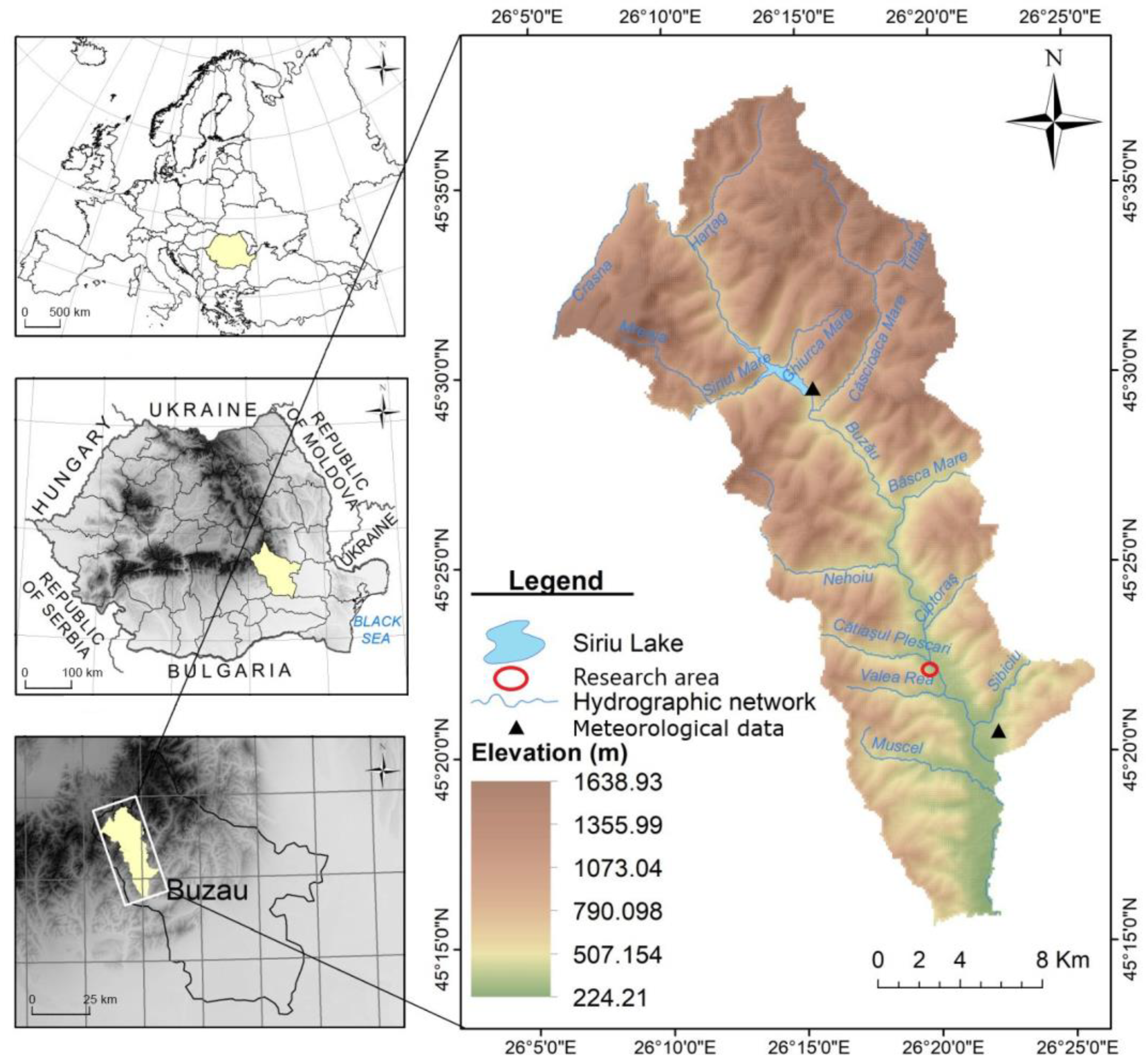
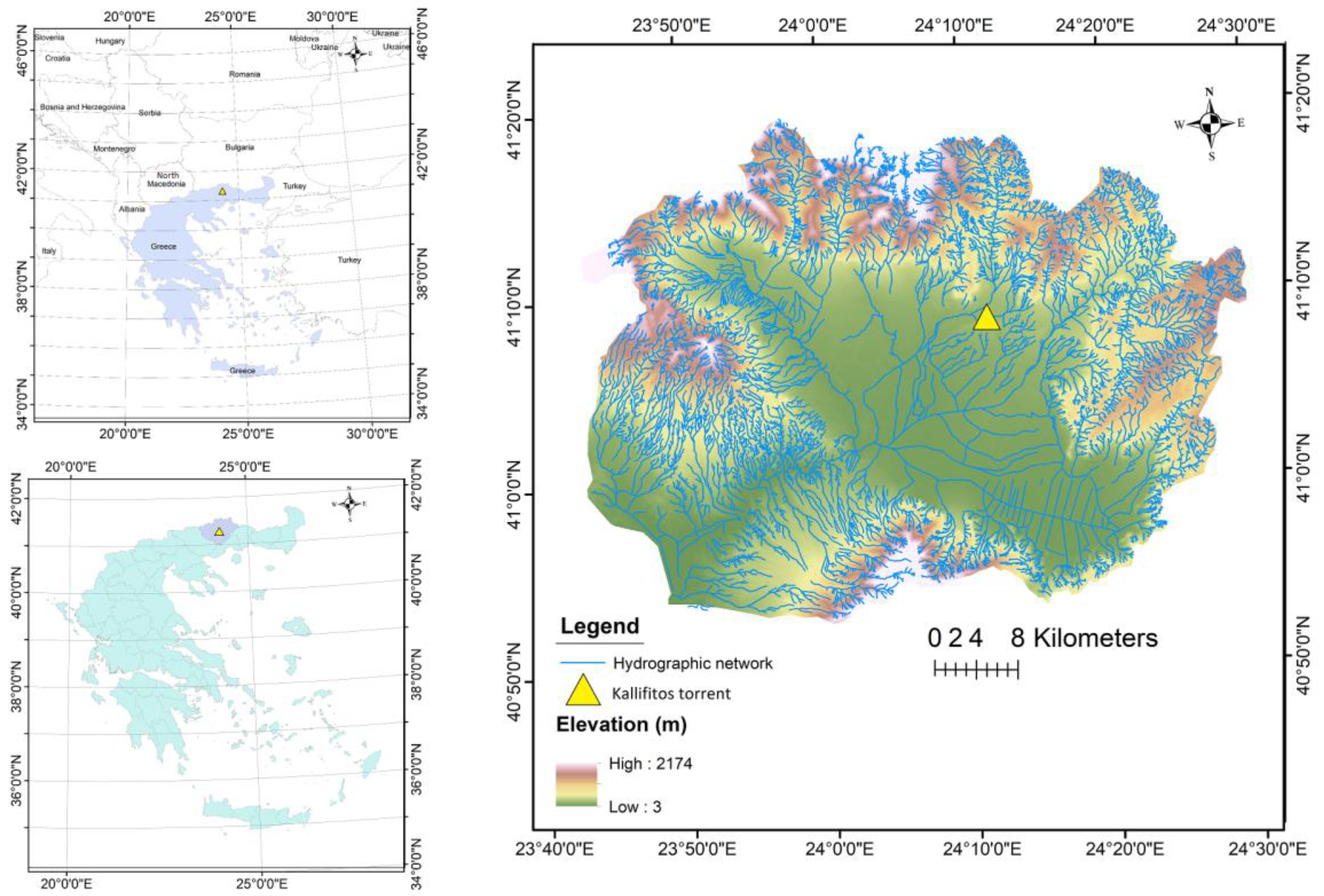
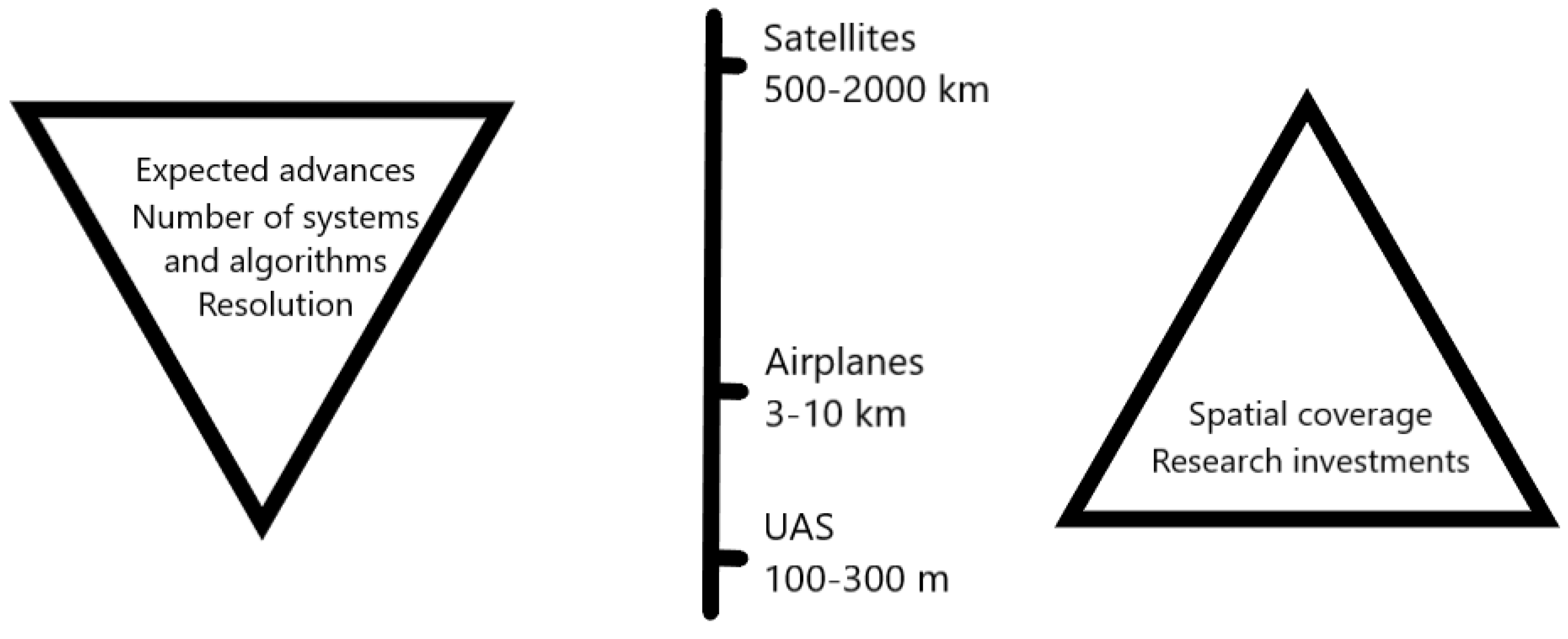
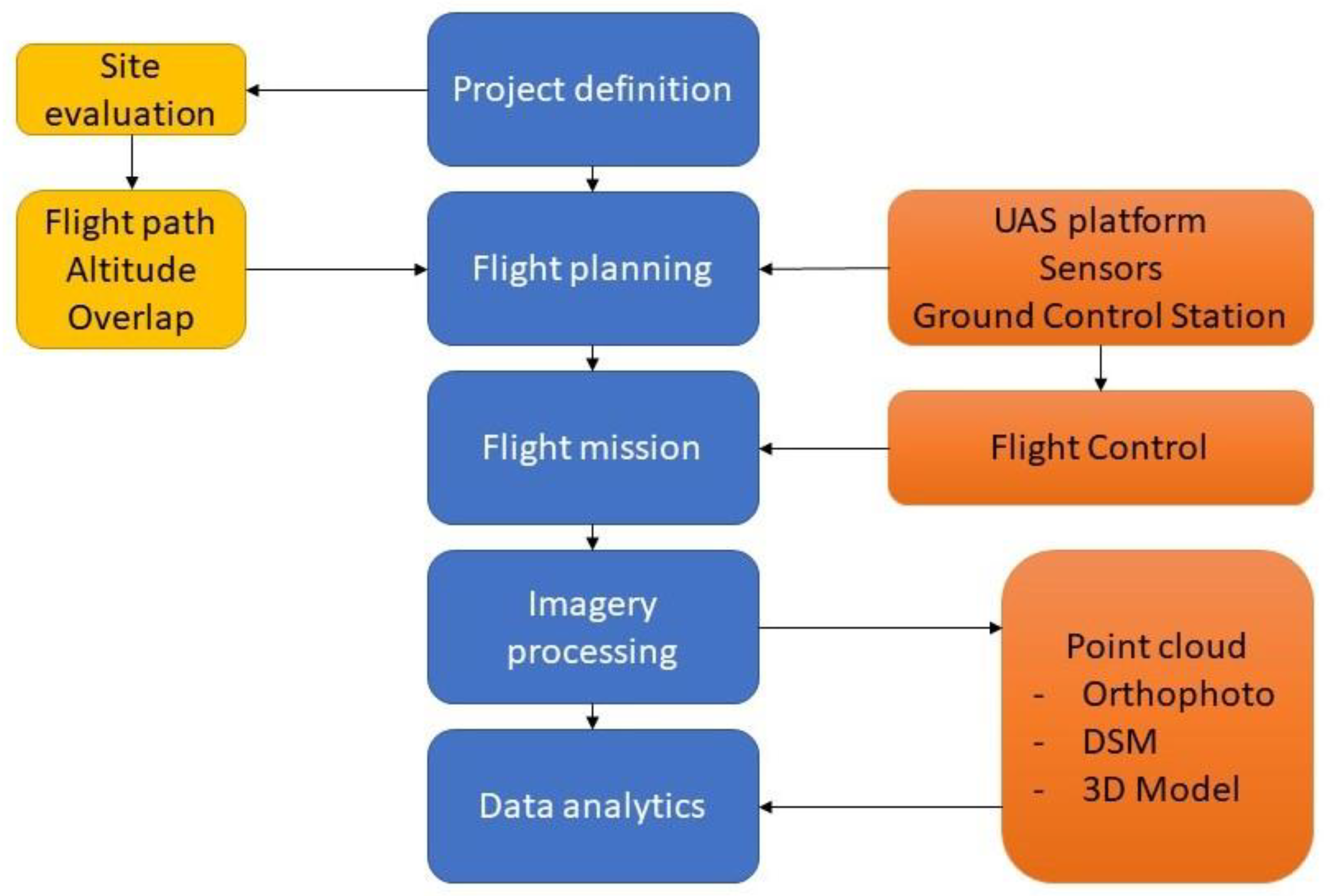
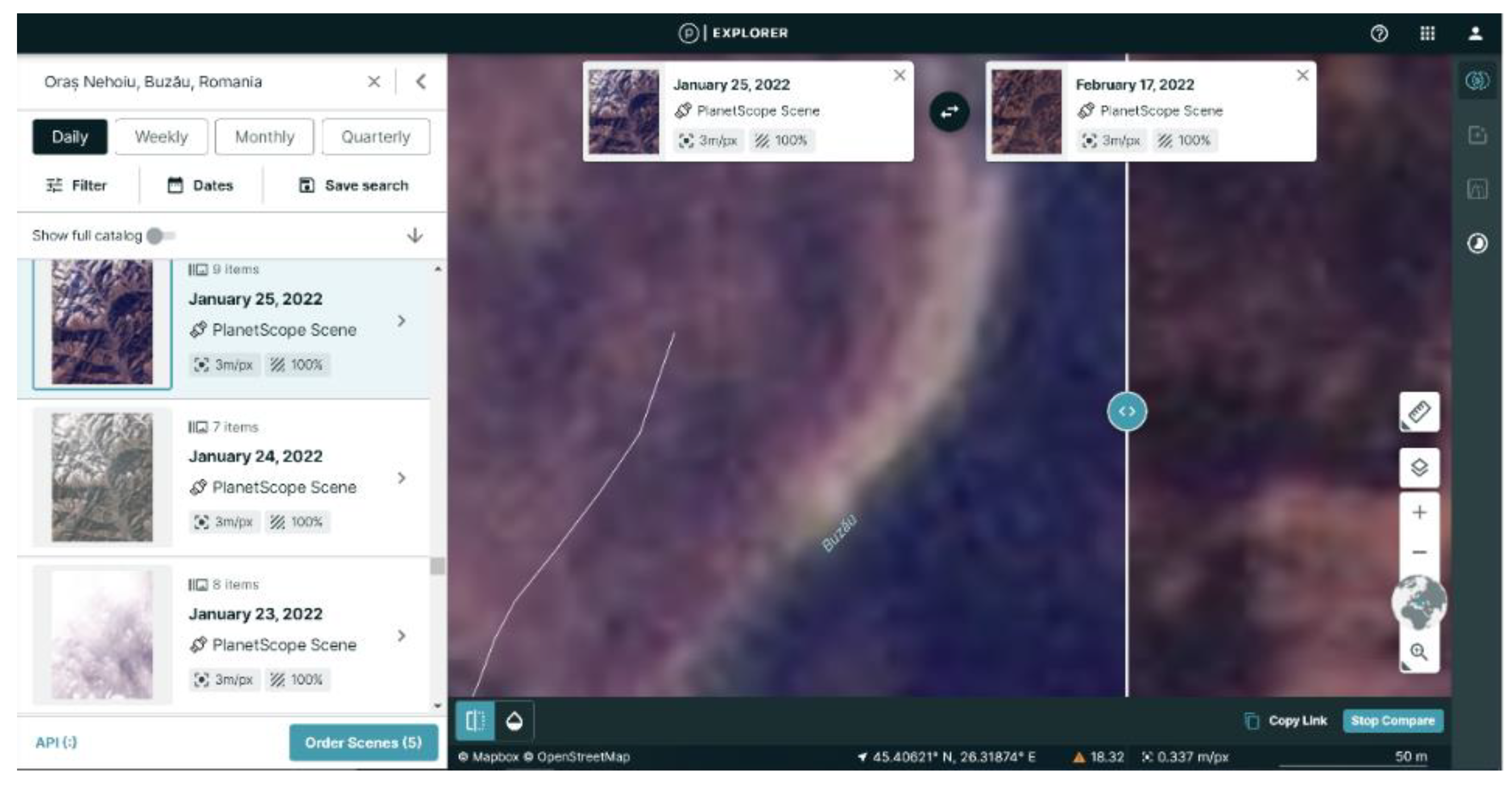

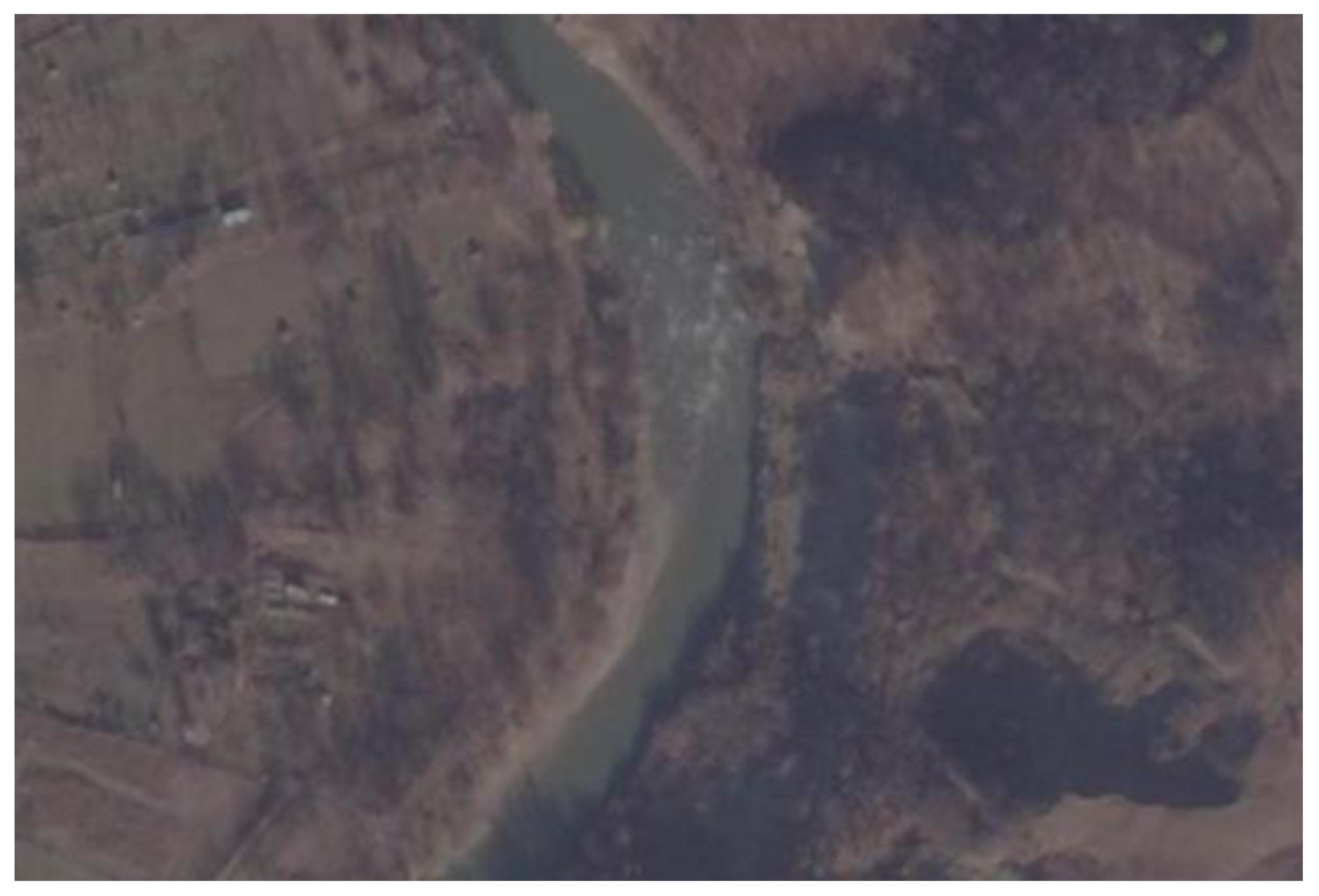
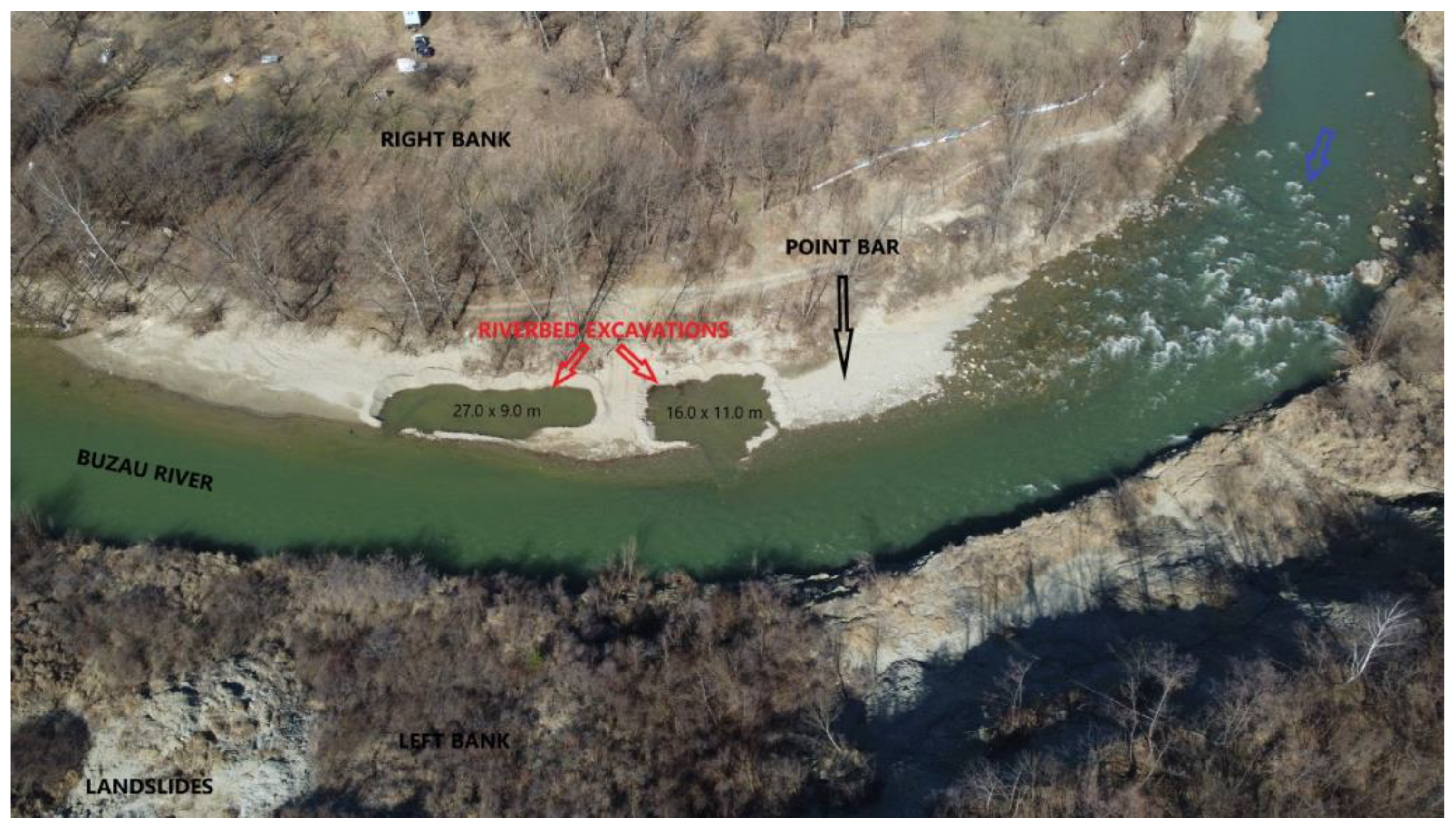
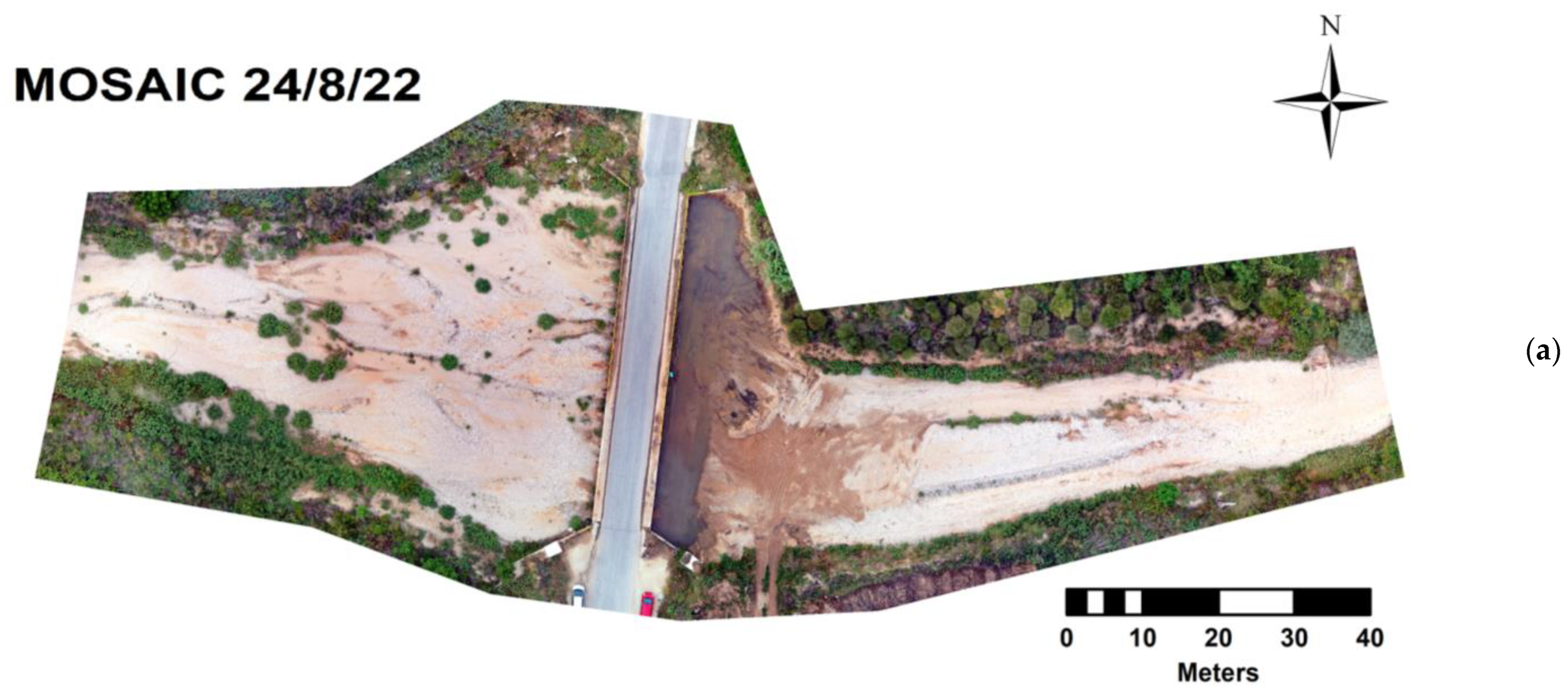
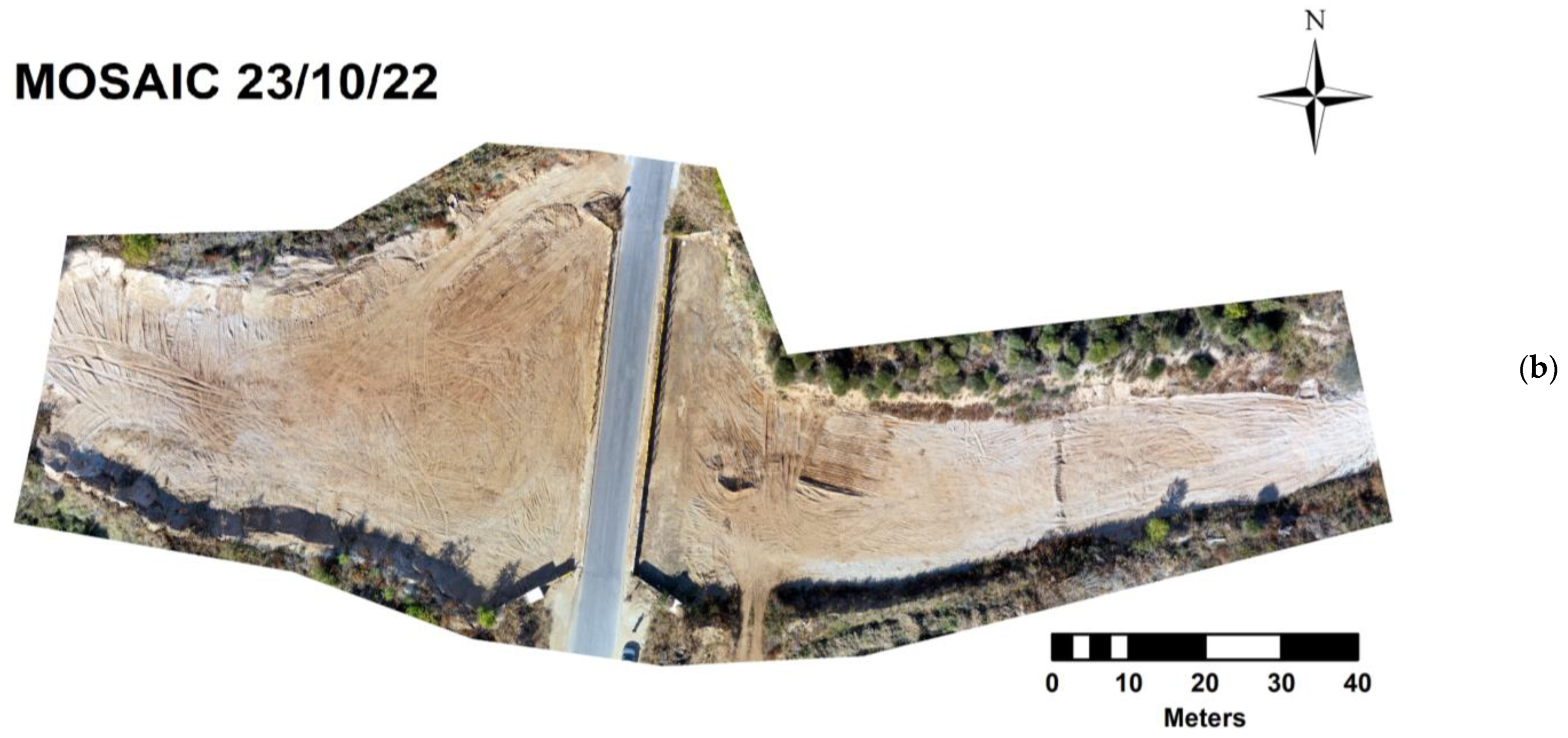
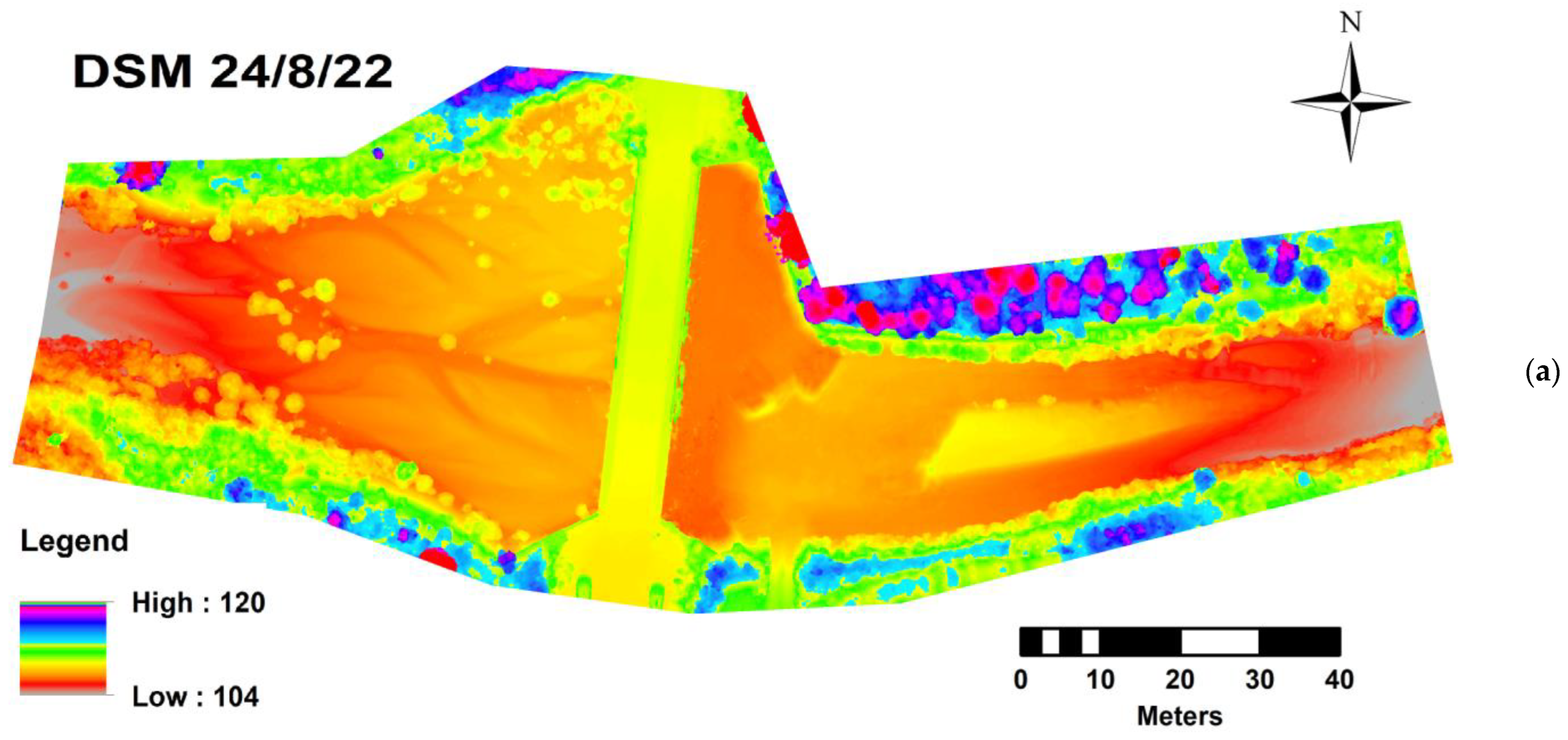

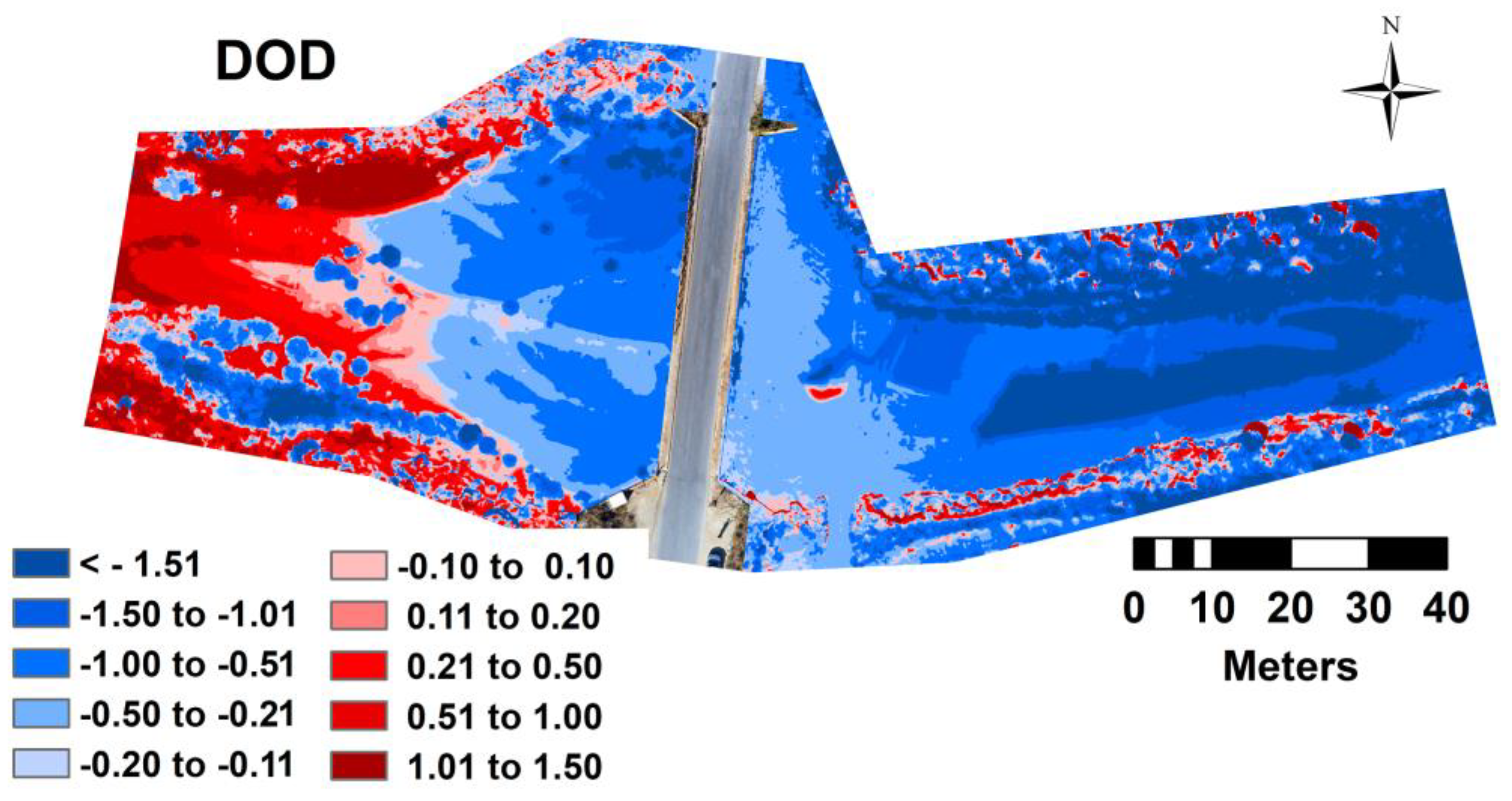
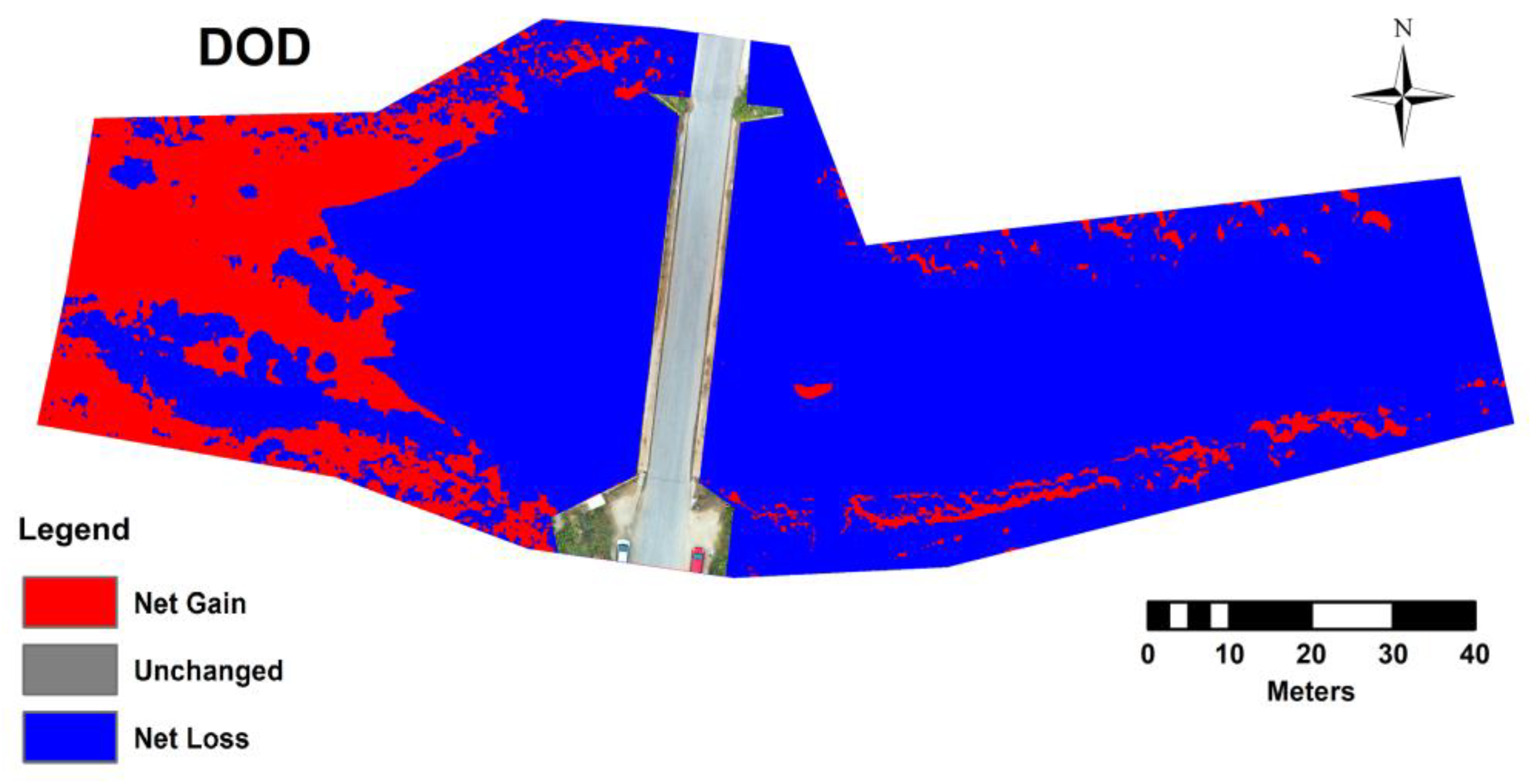

| Date of Image | Satellite Image Source | Spatial Resolution |
|---|---|---|
| 25 January 2022 | PlanetScope | 3 m/px |
| 17 February 2022 | PlanetScope | 3 m/px |
| 24 November 2021 | Skysat | 0.75 m/px |
Disclaimer/Publisher’s Note: The statements, opinions and data contained in all publications are solely those of the individual author(s) and contributor(s) and not of MDPI and/or the editor(s). MDPI and/or the editor(s) disclaim responsibility for any injury to people or property resulting from any ideas, methods, instructions or products referred to in the content. |
© 2023 by the authors. Licensee MDPI, Basel, Switzerland. This article is an open access article distributed under the terms and conditions of the Creative Commons Attribution (CC BY) license (https://creativecommons.org/licenses/by/4.0/).
Share and Cite
Diaconu, D.C.; Koutalakis, P.D.; Gkiatas, G.T.; Dascalu, G.V.; Zaimes, G.N. River Sand and Gravel Mining Monitoring Using Remote Sensing and UAVs. Sustainability 2023, 15, 1944. https://doi.org/10.3390/su15031944
Diaconu DC, Koutalakis PD, Gkiatas GT, Dascalu GV, Zaimes GN. River Sand and Gravel Mining Monitoring Using Remote Sensing and UAVs. Sustainability. 2023; 15(3):1944. https://doi.org/10.3390/su15031944
Chicago/Turabian StyleDiaconu, Daniel Constantin, Paschalis D. Koutalakis, Georgios T. Gkiatas, Gabriel Vasile Dascalu, and George N. Zaimes. 2023. "River Sand and Gravel Mining Monitoring Using Remote Sensing and UAVs" Sustainability 15, no. 3: 1944. https://doi.org/10.3390/su15031944
APA StyleDiaconu, D. C., Koutalakis, P. D., Gkiatas, G. T., Dascalu, G. V., & Zaimes, G. N. (2023). River Sand and Gravel Mining Monitoring Using Remote Sensing and UAVs. Sustainability, 15(3), 1944. https://doi.org/10.3390/su15031944











